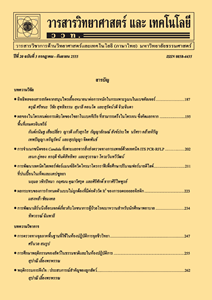Application of Natural Reagent from Orchid Flower as Indicator for Volumetric Acid-base Titration
Main Article Content
Abstract
A green analytical chemistry method employing crude aqueous extracted from the orchid flower Dendrobium Sonia ‘Earsakul’ as an acid-base indicator for acid-base titration was reported. In the orchid extract, there are many anthocyanin compounds which are red in acidic solution, purple in neutral solution and greenish-yellow in alkaline solution. When the orchid extract was utilized as indicators in acid-base titrations, sharp color changes at the equivalence point were observed. Titration curves of a strong acid, and weak acid to strong base were demonstrated. Moreover, the equivalence points obtained by the orchid extract were coincided with those of standard indicators and potentiometric titration. Additionally, this method was successfully applied for the determination of the total acidity in cooking vinegar samples and the measured values were reported as the percentage of acetic acid content. Our results were not significantly different from the standard AOAC method as well as potentiometric titration at a 95 % confidence level (ANOVA test). This indicated that orchid extract was acceptable to be used as a natural acid – base indicator, which was also economical, simple, accurate and reliable.
Article Details
References
Armenta, S., Garrigues, S. and de la Guardia, M., 2008, Green analytical chemistry, TrAC Trends in Anal. Chem. 27: 497-511.
Chigurupati, N., Saiki, L., Gayser, C.Jr. and Dash, A.K., 2002, Evaluation of red cabbage dye as a potential natural color for pharmaceutical use, Int. J. Pharm. 241: 293-299.
Bhagat, V.C., Patil, R.D., Channekar, P.R., Shetty, S.C. and Akarte Bhagat, A.S., 2008, Herbal indicators as a substituent to synthetic indicators, Int. J. Green Pharm. 2: 162-163.
Sukaram, T., Sirisakwisut, P., Sirirak J., Nacapricha D. and Chaneam, S., 2018, Environmentally friendly method for determination of ammonia nitrogen in fertilisers and wastewaters based on flow injection spectrophotometric detection using natural reagent from orchid flower, Int. J. Environ. Anal. Chem. 98: 907-920.
Nwosu, F., Adekola, F. and Ihedioha, K., 2004, Simple titrimetric colour indicators from some natural flower petals, Centre point (Sci. Ed.) 12: 74-89.
Patil, S.B., Kondawar, M.S., Ghodke, D.S., Naikwade, N.S. and Magdum, C.S., 2009, Use of flower extracts as an indicator in acid-base titrations, Res. J. Pharm. Technol. 2: 421-422.
Pathade, K.S., Patil, S.B., Kondawar, M.S., Naikwade, N.S. and Magdum, C.S., 2009, Morus alba fruit-herbal alternative to synthetic acid base indicators, Int. J. ChemTech Res. 1: 549-551.
Fossen, T. and Øvstedal, D.O., 2003, Anthocyanins from flowers of the orchids Dracula chimaera and D. cordobae, Phytochemistry 63: 783-787.
Duangmal, K., Saicheua, B. and Sueeprasan, S., 2004, Roselle anthocyanins as a natural food colorant and improvement of its colour stability, pp. 155-158, in Proceedings of AIC 2004 Color and Paints, Interim Meeting of the International Color Association, Chulalongkorn University, Bangkok.
Ersus, S. and Yurdagel, U., 2007, Micro encapsulation of anthocyanin pigments of black carrot (Daucus carota L.) by spray drier, J. Food Eng. 80: 805-812.
Markwell, J., Curtright, R. and Rynearson, J.A., 1996, Anthocyanins: Model com pounds for learning about more than pH, J. Chemical Edu. 73: 306-309.
Li, J. and Jiang, Y., 2007, Litchi flavonoids: Isolation, identification and biological activity, Molecules 12: 745-758.
Castaneda-Ovando, A., Pacheco-Hernández, M., Páez-Hernández, M.E., Rodríguez, J.A. and Galán-Vidal, C.A., 2009, Chemical studies of anthocyanins: A review, Food Chem. 113: 859-871.
Health, M.O.P., 2000, Notification of the Ministry of Public Health: Vinegar, Prachachon, Bangkok.
Horwitz, W., 2000, Official methods of analysis of the Association of Official analytical Chemists (AOAC) International, AOAC International, Maryland.
Kaewkiew, J., Nabnean, S. and Janjai, S., 2012, Experimental investigation of the performance of a large-scale greenhouse type solar dryer for drying chilli in Thailand, Proc. Eng. 32: 433-439.
Janjai, S., Intawee, P., Kaewkiew, J., Sritus, C. and Khamvongsa, V., 2011, A large-scale solar greenhouse dryer using polycarbonate cover: Modeling and testing in a tropical environment of Lao People’s Democratic Republic, Renew. Energy 36: 1053-1062.
Horwitz, W., 2000, Official methods of analysis of the Association of Official analytical Chemists (AOAC) International, AOAC International, Maryland.
Lee, J., Durst, R.W. and Wrolstad, R.E., 2005, Determination of total monomeric anthocyanin pigment content of fruit juices, beverages, natural colorants, and wines by the pH differential method: Collaborative study, J. AOAC Int. 88: 1269-1278.
Jiangrong, L. and Yueming, J., 2007, Litchi flavonoids: Isolation, identification and biological activity, Molecules 12: 745-758.
Miller., J. and Miller, J.C., 2018, Statistics and Chemometrics for Analytical Chemistry, Pearson Education, Ltd., London.


